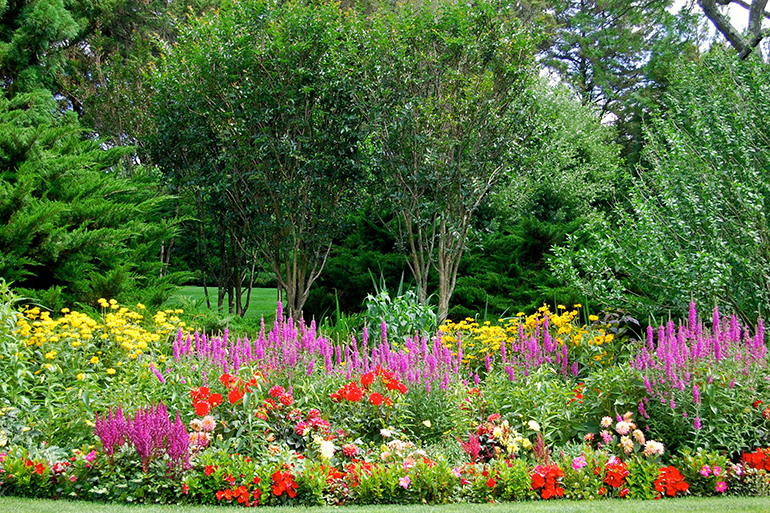Notes from the Garden: Using Color for Your Hamptons Garden

A garden can be designed to achieve a particular color effect whenever plant colors are introduced into a garden with flowers, trees or shrubs. Great care should be taken with their arrangement to achieve an exciting design.
Color association is usually a matter of personal taste. A color wheel shows the colors of visible light (in this order); red, orange, yellow, green, blue, indigo and violet. This is very useful for choosing combinations as it shows what colors will compliment or contrast one another. Choosing contrasting colors, which appear on opposite sides of the wheel, will maximize the color effect. For example: violet looks more intense when used with orange or yellow. However, colors that are next to one another on the wheel will be complimentary and result in a harmonious composition. Vibrant colors such as yellows, oranges, reds and violets will look better in full sun, while soft colors such as blues, lavender, pinks and greys will look best in partial or full shade. White looks good in all compositions or light intensities.
Colors are best grouped in bold, large clumps to avoid appearing spotty. Plants of the same variety should be grouped in clumps or drifts for greater visual impact and using odd numbers of plants will yield better results than even numbers. Trees, shrubs and flowers should be planted in a graduation of heights with tall plants in back and short ones up front for depth and visibility. Plants that bloom from spring to fall should be selected for a succession of blooms for color over a longer period.
An organic design needs curves and diagonals formed by shape and color weaving across the field of view to hold interest and involve the viewer in further visual exploration. Symmetry provides balance in a structured layout and can be created with horizontal forms and parallels using low-growing plants in beds such as: Calamintha, Nepeta and Rozanne Geraniums to edge paths. The beds or panels in these patterns can be made of flowers in different heights and shapes or only using one plant type like roses.
The simplest color scheme is built with a single color; this can perhaps be expressed in several different tones and with a small amount of secondary coloring added for accents. Whether the garden has all tones of violets or whites and greys to add more interest, a variety of flower shapes, plant heights, textures, bloom sizes and some plants with variegated foliage including Hosta and Carex should be added.
Balanced or complimentary colors are located near one another on the color wheel. Examples of this are red, orange and yellow, or blue and pink. Combining flowers with these colors can be quite dramatic when used in a border with red Peonies, purple Allium and yellow Achillea moonshine. Contrasting colors are farther apart or opposite one another on the color wheel, so placing them next to each other emphasizes their different qualities. These colors can include blue and yellow or purple and orange, which lay on opposite sides of the color wheel so when used in a garden they will contrast more intensely than most other juxtaposition of color.
Contrasting color schemes are very attractive and will look better at a distance or from across a lawn. Multicolored gardens containing a variety of colors usually work best when one color is dominant because it brings together the overall scheme. Visual impact is achieved by planting in color groups, in bands of drifts or clumps, such as a group of white Shasta Daisy followed by a group of blue Perovskia followed by a group of purple Lythrum. Combinations of these colors will attract more wildlife than any other kind.
A vegetable garden can also be very colorful as it turns herbs, flowers and vegetables into a patchwork quilt of color, texture and heights. Taller plants such as sweet peas and tomatoes on a trellis as a focal point, surrounded by smaller plants like different varieties of colorful lettuces, thyme and basil, with tiny flowers such as Violets, Alyssum and Marigolds (attracting beneficial insects) edging the garden.
Intensely colored flowers and foliage create an unusually beautiful look in pots, planters and urns by complimenting different outdoor areas. A simple mix of blooms among profuse foliage can give planters a lush feel because the foliage creates the perception of depth. A colorful flower arrangement offers a beautiful and chic design that will transform a stark wooden or stone deck, patio or terrace. Plants such as Lavender, Lantana, Scaviola and Lobelia can be mixed together in a container for a lush and scented flowering design.
Once the garden style is decided upon, the color scheme should then be considered. Colors of flowers and foliage can contrast with each other but should always harmonize as well as with the design of the garden and location where they are placed.
Landscape designer, writer and lecturer, Frederico Azevedo is the founder of Unlimited Earth Care, Inc., providing high quality landscape design and maintenance to the Hamptons since 1993. For more information, call 631-725-7551 or visit unlimitedearthcare.com.



